FIX Protocol Session Layer
FIX protocol messages are divided into two types.
- Session Layer Messages
- Application Messages
Session Layer Messages are for establishing, recovering and terminating FIX session. While application messages are to carry out business purposes such as buy, sell, sending/subscribing market data or sending execution reports.
FIX protocol session layer is a realization of layer 5 session layer of OSI model.
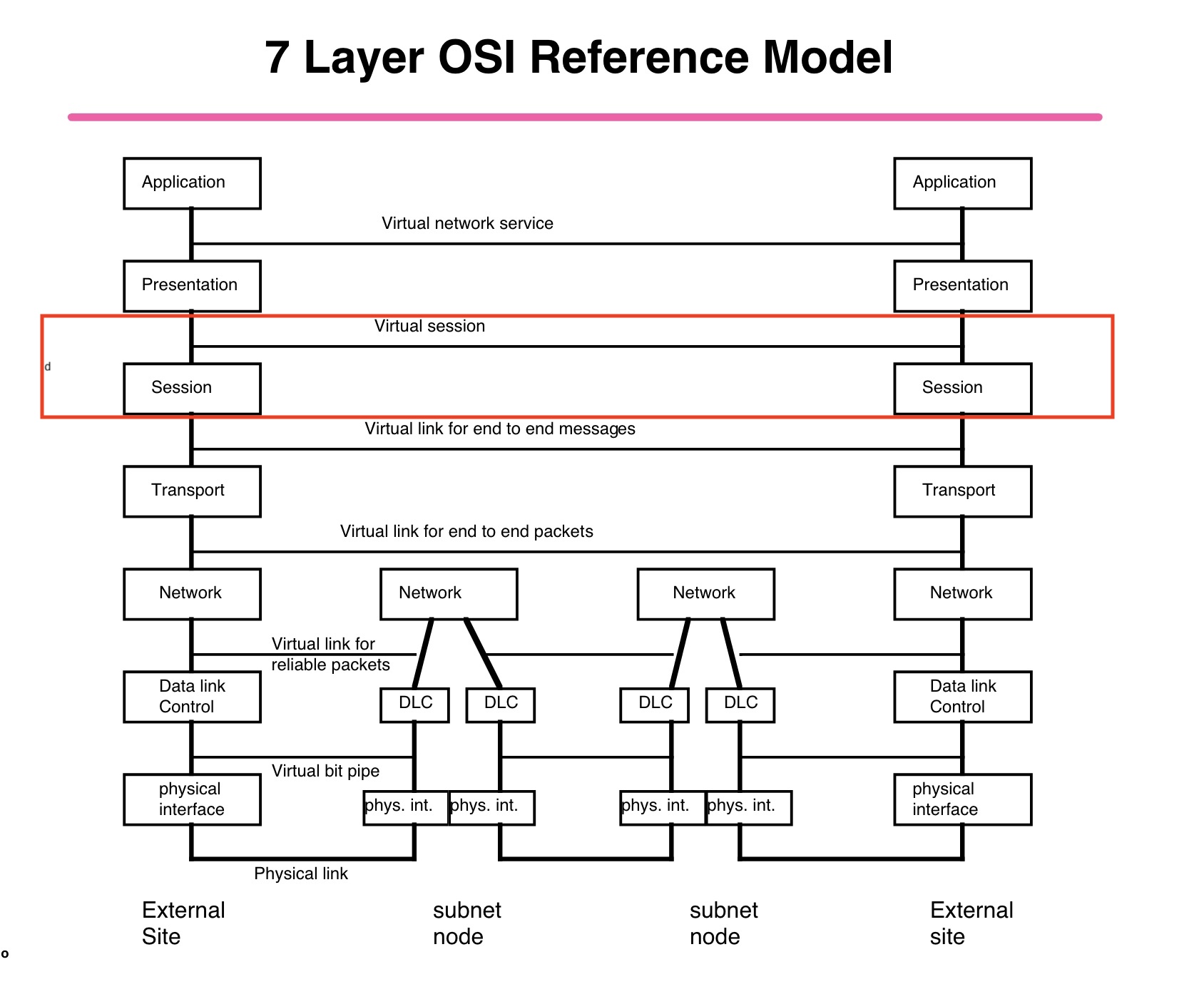 Image Reference - Data Networks - MIT
Image Reference - Data Networks - MIT
FIX session can exist multiple sequential FIX connections. FIX connection can be terminated due to various reasons such as application or network outages. But the FIX session can continue after re-establishing the FIX connection. There are various means provided in the FIX session layer specification to recover the session as well. Such as keeping track of NextNumIn, NextNumOut, Retransmission, Gap-Fill and Resend of messages.
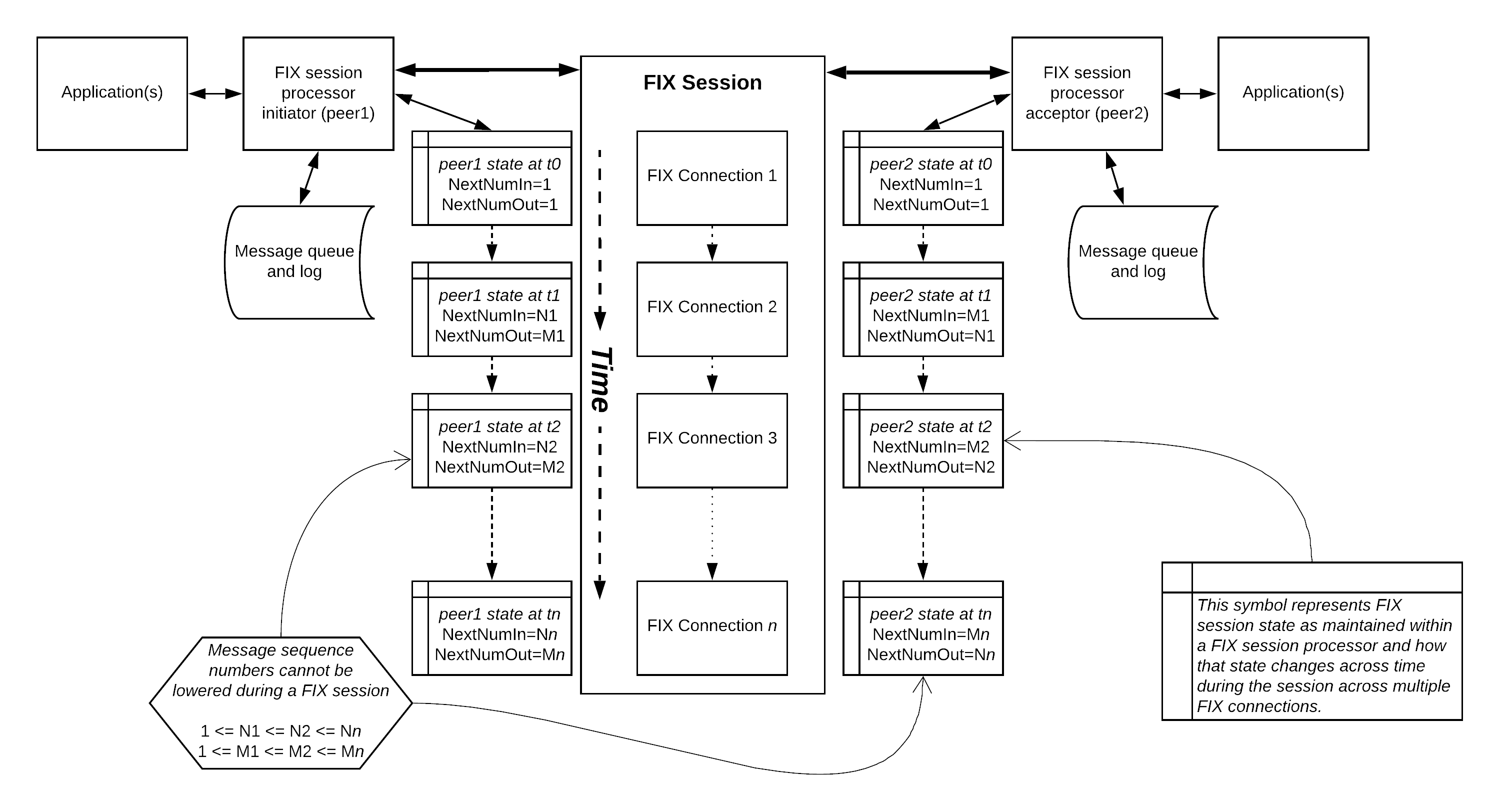
Image Reference - Session Across Sequential Connections
Establishing FIX Connection
Establishing FIX connection has three parts.
- Transport Layer Connection
- Acceptance with optional authentication
- Message synchronization
FIX session time-span
FIX session usually exists for agreed time-span by two peers (acceptor and initiator). It can be weekly or daily sessions. This weekly and daily session timing are agreed by out-of-band communications. Which means no session layer message will specify the duration of the session. Which we called the in-band communication. Two counterparties agree upon session timing as part of their rules of engagement.
Since I briefly mention in-band communication. Example for in-band communication is the heart beat interval. Which used by peers to check on each other’s live-ness. HeartBtInt(tag 108) is set in initiators logon request (35=A) to specify this value. Hence, its in-band communication.
Important out-of-band parameters
Following out-of-band parameters are important to the session layer.
| Configuration | Description |
|---|---|
| TestRequestThreshold | Amount of time expressed as a multiplier of heartbeat interval before TestRequest(35=1) send to the peer. |
| SendingTimeThreshold | Amount of time expressed in seconds in which SendingTime(tag 52) in an inbound message can differ from system time of the receiving peer. |
| LogOutAckThreshold | Amount of time express in seconds where FIX peer who has sent Logout(35=5) will wait for its peer to reply with Acknowledgement, if execeed it will terminate the transport layer connection. |
Heartbeat interval determination
In QuickFIXJ initiator will specify the HeartBtInt(108) tag in the logon request (35=A). Acceptor which may or may not be QuickFIXJ based implementation, will also send HeartBeatInt(108) in its logon request. Acceptor may echo back the value send by the initiator, or send a different value. Or it can even reject the logon request. Initiator can also reject the logon message send by acceptor if it does not agree with the amend for the HeartBeatInt.
| Configuration | Description | Values |
|---|---|---|
| HeartBtInt | Heartbeat interval in seconds. Only used for initiators. | positive integer |
Following is a QFJ log from the perspective of the accepting peer. HeartBtInt configuration is mandatory for QFJ initiator peer. Acceptor will switch to the heart beat interval set by the initiator in the logon request.
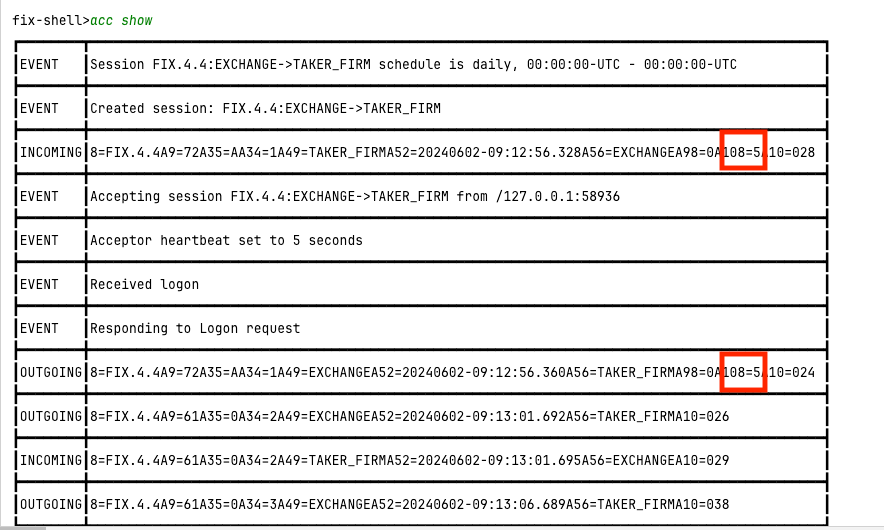
Above screenshot is from the output of the qfj-fix-shell
Message Recovery
FIX message synchronization after logon request has been send considered to be recoverable if the followings are true.
peer1.NextNumOut >= peer2.NextNumIn
peer2.NextNumOut >= peer1.NextNumIn
What this means is peer’s NextNumOut should be always equal or smaller than other peer’s expected NextNumIn. If there is need for message synchronization, then it can be done using ResendRequest(35=2) and SequenceReset(35=4) messages which follows the Logon(35=A) messages.
Scenario 1 - Acceptor requires retransmission of messages from initiator
Let’s take a scenario where Initiator’s NextNumOut is larger number than the Acceptor’s NextNumIn.
initiator.NextNumOut > acceaptor.NextNumIn
initiator.NextNumIn = acceaptor.NextNumOut
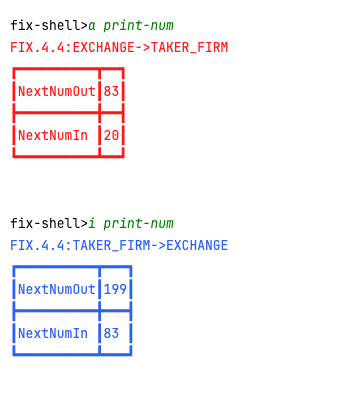
Above figure shows a scenario I have created using qfj-fix-shell. Where initiator’s NextNumIn and acceptor’s NextNumOut matches(83), but initiator’s NextNumOut (199) is larger than acceptor’s NextNumIn (20).
Let’s assume on the initiator side message sequence for un-synced outgoing messages would look like this.
| Sequence Number(s) | Type of Message |
|---|---|
| 20-152 | Session Layer Messages |
| 153 | Application Layer Message |
| 154 | Session Layer Message |
| 155 | Application Layer Message |
| 156-199 | Session Layer Messages |
Recovery process

| Step | Remark |
|---|---|
| 1 | Initiator send logon(35=A) request |
| 2 | Acceptor respond with logon(35=A) request |
| 3 | Acceptor resend reqeust (35=2) for missing messages between 20 to infinity BeginSeqNo<7>=20 and EndSeqNo<16>=0. |
| 4 | Initiator send sequence reset (35=4) with NewSeqNo<36>=153 and GapFill<123>=Y. Reason is there is no application messages till sequence number 152 |
| 5 | Initiator send application message NewOrderSingle(35=D) with PossDupFlag<43>=Y to denote that this is possible duplicate message. |
| 6 | Initiator send sequence reset (35=4) with NewSeqNo<36>=155 and GapFill<123>=Y. Reason is there is no application messages till sequence number 154 |
| 7 | Initiator send applicatoin message NewOrderSingle(35=D) with PossDupFlag<43>=Y to denote that this is possible duplicate message. |
| 8 | Initiator send sequence reset (35=4) with NewSeqNo<36>=200 and GapFill<123>=Y. Reason is there is no application messages till sequence number 199 |
| 9 | Acceptor send HeartBeat message (35=0), and conclude the message recovery |
Scenario 2 - Initiator requires retransmission of messages from acceptor
Let’s take a scenario where Initiator’s NextNumOut is larger number than the Acceptor’s NextNumIn.
initiator.NextNumOut = acceaptor.NextNumIn
initiator.NextNumIn < acceaptor.NextNumOut
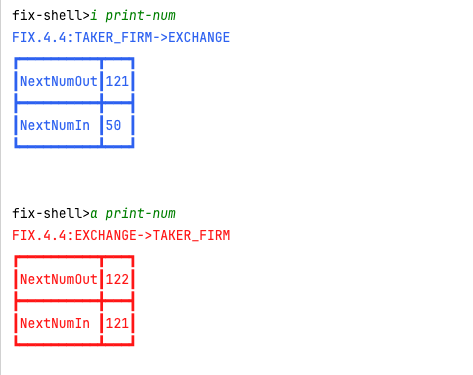
Above figure shows a scenario I have created using qfj-fix-shell. Where initiator’s NextNumOut and acceptor’s NextNumIn matches(121), but initiator’s NextNumIn (50) is smaller than acceptor’s NextNumOut (122).
Let’s assume on the acceptor side message sequence for un-synced outgoing messages would look like this.
| Sequence Number(s) | Type of Message |
|---|---|
| 50-63 | Session Layer Messages |
| 64 | Application Layer Message |
| 65-73 | Session Layer Message |
| 74 | Application Layer Message |
| 75-122 | Session Layer Messages |
Recovery process
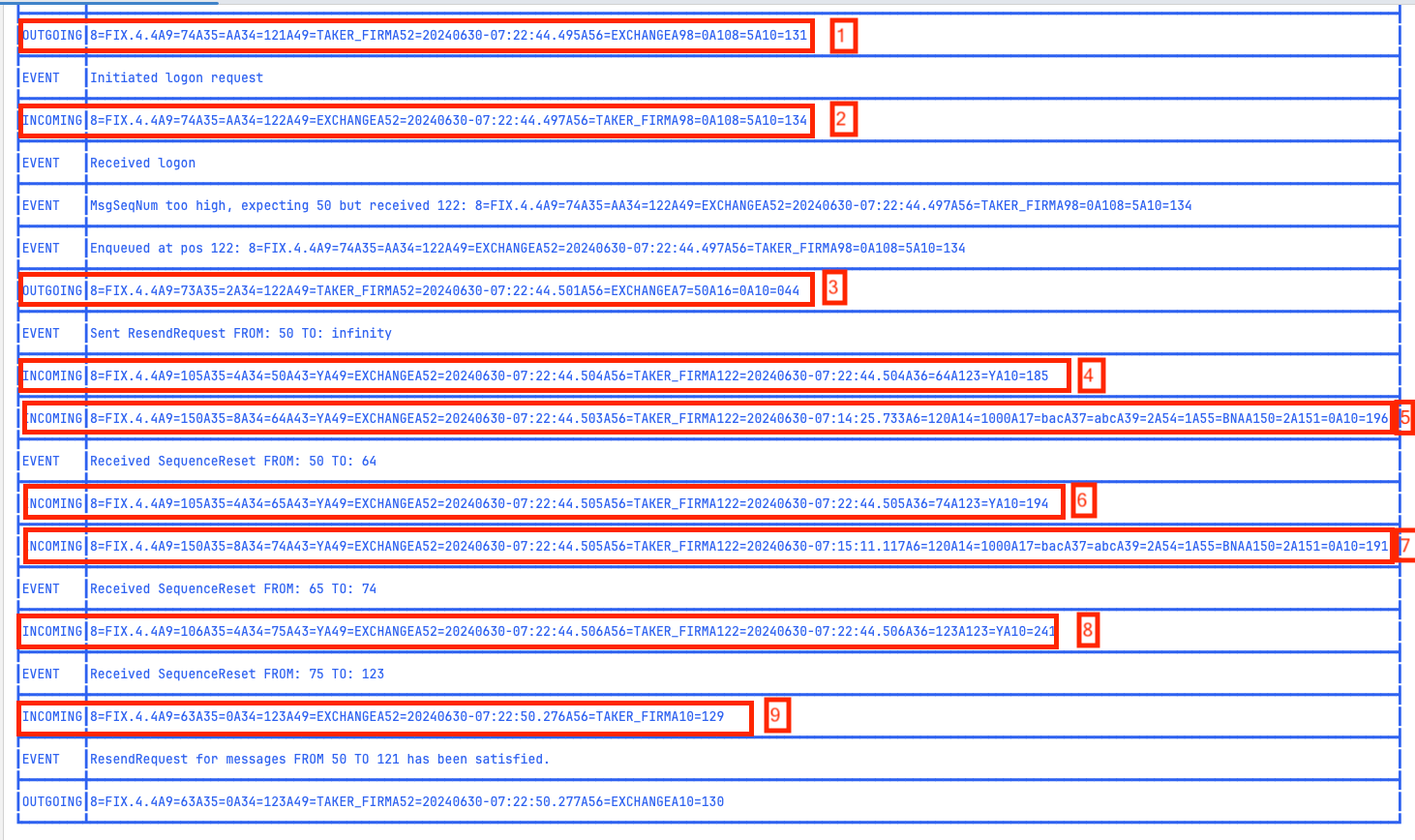
| Step | Remark |
|---|---|
| 1 | Initiator send logon(35=A) request |
| 2 | Acceptor respond with logon(35=A) request |
| 3 | Initiator resend reqeust (35=2) for missing messages between 50 to infinity BeginSeqNo<7>=50 and EndSeqNo<16>=0. |
| 4 | Acceptor send sequence reset (35=4) with NewSeqNo<36>=64 and GapFill<123>=Y. Reason is there is no application messages till sequence number 63 |
| 5 | Acceptor send application message ExecutionReport(35=8) with PossDupFlag<43>=Y to denote that this is possible duplicate message. |
| 6 | Acceptor send sequence reset (35=4) with NewSeqNo<36>=74 and GapFill<123>=Y. Reason is there is no application messages till sequence number 73 |
| 7 | Acceptor send applicatoin message ExecutionReport(35=8) with PossDupFlag<43>=Y to denote that this is possible duplicate message. |
| 8 | Acceptor send sequence reset (35=4) with NewSeqNo<36>=123 and GapFill<123>=Y. Reason is there is no application messages till sequence number 122 |
| 9 | Acceptor send HeartBeat message (35=0), and conclude the message recovery |
Scenario 3 - Both initiator requires retransmission of messages from acceptor
Let’s take a scenario where Initiator’s NextNumOut is larger number than the Acceptor’s NextNumIn.
initiator.NextNumOut > acceaptor.NextNumIn
initiator.NextNumIn < acceaptor.NextNumOut
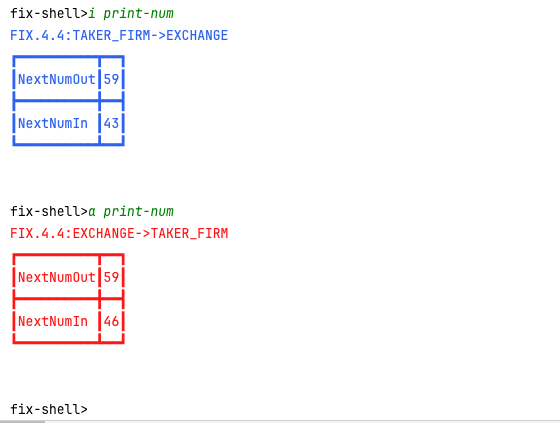
Above figure shows a scenario I have created using qfj-fix-shell. Where initiator’s NextNumOut(59) is larger than acceptor’s NextNumIn(46), and initiator’s NextNumIn (43) is smaller than acceptor’s NextNumOut (59).
Let’s assume on the acceptor side message sequence for un-synced outgoing messages would look like this.
| Sequence Number(s) | Type of Message |
|---|---|
| 43-54 | Session Layer Messages |
| 55 | Application Layer Message |
| 56-60 | Session Layer Message |
Let’s assume on the initiator side message sequence for un-synced outgoing messages would look like this.
| Sequence Number(s) | Type of Message |
|---|---|
| 46-49 | Session Layer Messages |
| 50 | Application Layer Message |
| 51-60 | Session Layer Message |
Recovery process
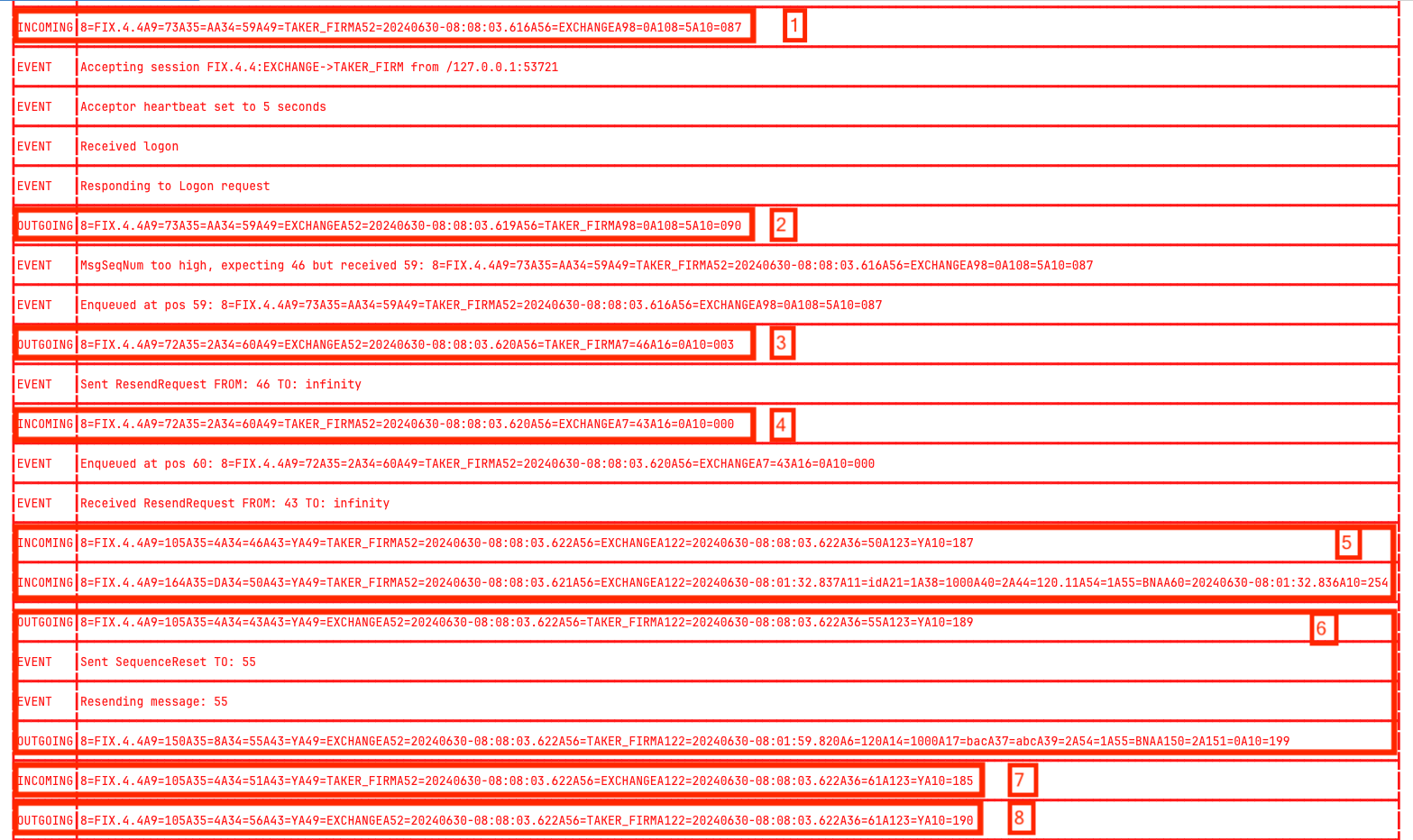

| Step | Remark |
|---|---|
| 1 | Initiator send logon(35=A) request |
| 2 | Acceptor respond with logon(35=A) request |
| 3 | Acceptor send resend reqeust (35=2) for missing messages between 46 to infinity BeginSeqNo<7>=46 and EndSeqNo<16>=0. |
| 4 | Initiator send resend reqeust (35=2) for missing messages between 43 to infinity BeginSeqNo<7>=43 and EndSeqNo<16>=0. |
| 5 | Initiator send a gap fill message, followed by NewOrderSingle message |
| 6 | Acceptor send a gap fill message, followed by ExecutionReport message |
| 7 | Initiator send a gap fill message for session layer messages |
| 8 | Initiator send a gap fill message for session layer messages |
| 9 | Initiator and acceptor start heart beating to each other to conclude the message recovery |
Best Practices
Always send a TestRequest(35=1) upon Login(35=A)
Initiator and Acceptor require to perform message synchronization after each peer received the logon request, and logon request SequenceNumber does not match with the expected NextNumIn for the respective peer. A good practice is to send TestRequest(35=1) to force message synchronization the peer to send a HeartBeat(35=0), before sending any queued application level messages.
References
FIX Session Layer Complete References
01 Jun 2024 - Isuru